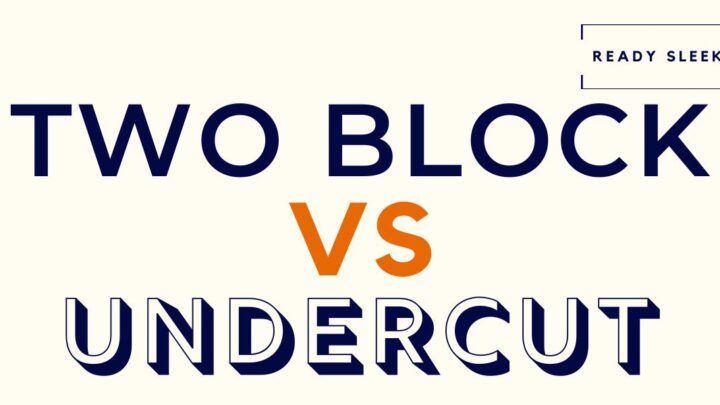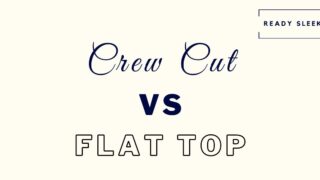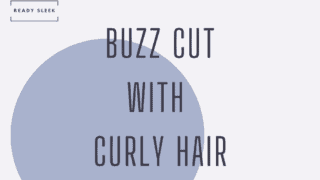These two styles are very commonly confused with each other. While they share a couple of key similarities, the differences are essential to get to grips with. So, what’s the difference between a two-block haircut and an undercut?
Both two-blocks and undercuts have a disconnected appearance due to the sharp transition from short sides to a long top. The difference is that this disconnection occurs higher up the sides with an undercut. In addition, two-blocks usually have a wispy fringe while undercuts are often slicked back.
Although that’s the short answer, there’s more to it.
After going through the main differences between the two, I’ll go through some practical tips for choosing which one is right for you.
Let’s get to it.
Two Block Vs Undercut: 3 Key Differences
Having a good understanding of the differences is crucial to know which one is right for you. Consider the following three.
1. Disconnection Height
Both undercuts and two-blocks are disconnected styles which means that the sides aren’t blended into the top. Instead, there’s a sharp transition between the two.
It’s this disconnection that often leads to the two styles being confused with each other.
But the main difference between the two is the height at which this disconnection becomes visible.
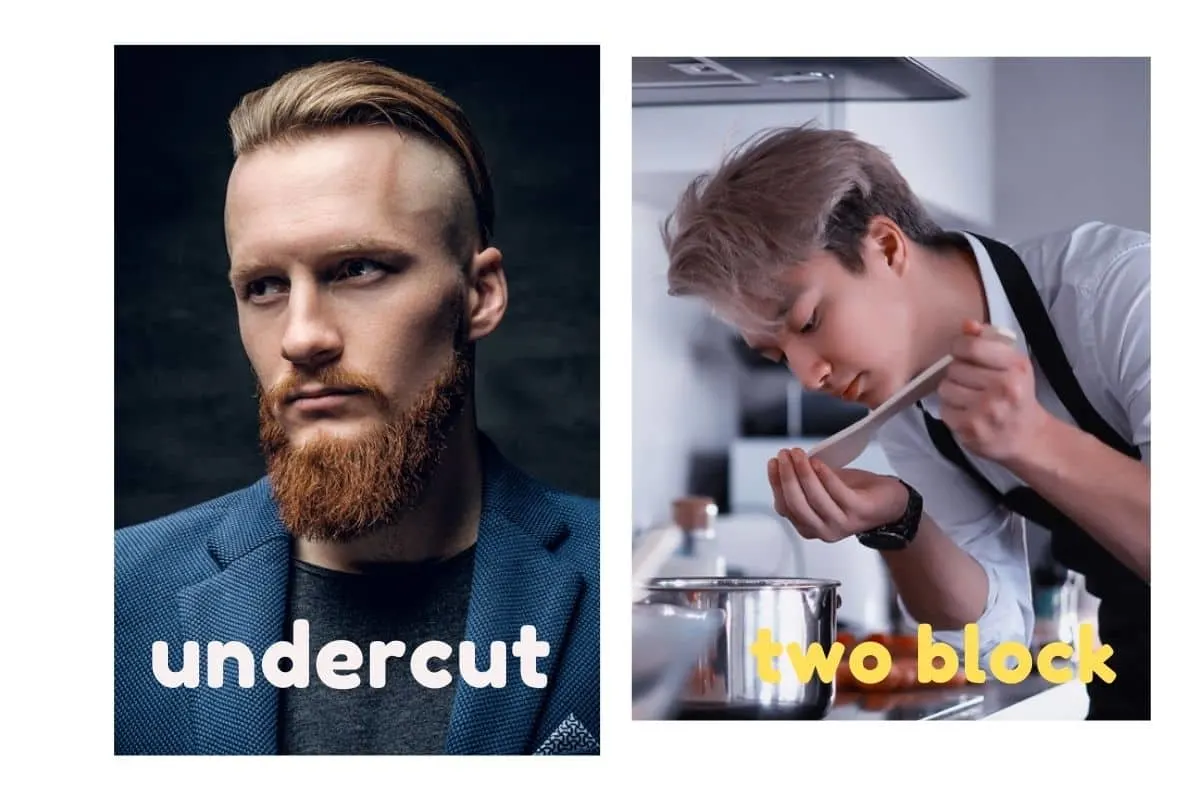
Let’s look at each of the styles in turn.
Undercuts are styles where the sides are shaved or buzzed down short and the top is left long, but the transition between the short sides and the long sides occurs high up.
The sudden transition from short to long hair often occurs as high up as the temples, right at the boundary between the sides and the top.
Two-blocks also usually have the sides buzzed down all the way to the top. However, the hair on the top of the head is left long enough to pull most of the way down both sides.
Because of this, the transition from short hair to long hair appears to occur lower down the sides (around midway up) than with undercuts.
2. Slick Back Vs Fringe
The classic undercut often has the long hair on top slicked back.
However, it’s important to note that this isn’t considered essential these days. What defines the undercut is the disconnection between the short sides and long top, not the slick back.
You can get undercuts (with their typical disconnection) that don’t have the hair slicked back and still reasonably label it an “undercut”.
But the traditional undercut usually has the hair slicked back.
In contrast, the two-block haircut usually has the hair on top pulled forward into a wispy and messy fringe.

Image From Deposit Photos
This, together with the disconnection that occurs midway up the sides, gives the two-block a pretty unique appearance.
3. Length Contrast
With undercuts, the contrast between the short sides and the long top is usually greater and more striking than that of a two-block.
The long, slicked-back hair of an undercut looks especially bold given the sides are often completely shaved up to the top or buzzed down to a very short length at least.
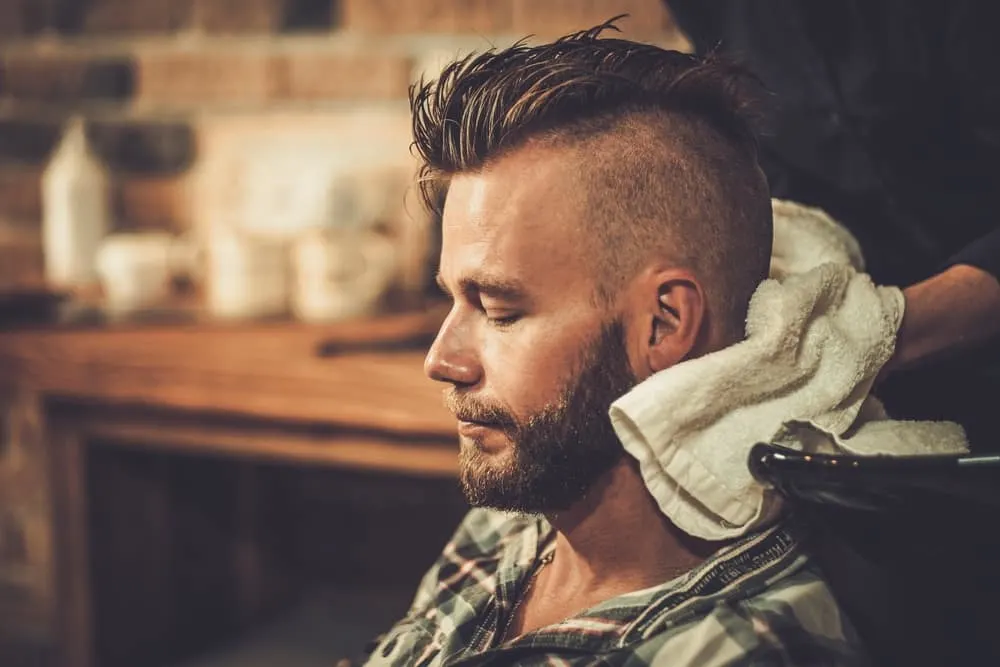
Image From Deposit Photos
While there is still a sharp contrast between the long, wispy, fringe of a two-block and the buzzed sides, the contrast isn’t usually quite as large.
You don’t usually get two-blocks with the sides shaved all the way down. Instead, they’re usually buzzed down to a short length (eg. #1 or #2 length).
This is definitely short enough to produce a very noticeable contrast with the long hair on top. It’s just that you’d usually get a greater amount of contrast with an undercut.
Two Block Vs Undercut: How To Choose
Now that you know the main differences between these two styles, how do you decide which one is for you?
1. Required Length
Undercuts generally require more length than two-blocks.
With both styles, you’ll need enough length for there to be a significant contrast between the top and the buzzed sides.
Two-blocks require enough length for that classic, wispy fringe.
However, if you were looking to style a traditional undercut with the top slicked all the way back, you’d usually need longer hair than you would with a two-block.
To successfully slick hair back and keep it that way, you’d usually need at least 5 to 6 inches of length.

While it’s possible to train hair to slick back even when it’s a little shorter, it isn’t easy.
Two-blocks tend to look better with long, jagged fringes. However, it’s definitely possible to style a two-block with 2 or 3 inches of length up top.
It would still be obvious that it was a two-block if you had the typical disconnection midway up the sides.
So, the length of hair you’ve got to work with may be the deciding factor when choosing between the two styles.
If you aren’t willing to tolerate at least 5 or 6 inches of length, a traditional undercut may not be the one for you. Consider the two-block instead.
2. Maintenance
Undercuts are generally higher maintenance than two-blocks.
This is for a couple of different reasons.
One is that undercuts usually require longer hair which in turn gives you higher maintenance requirements.
More washing, brushing, combing, etc.
In addition, undercuts usually have the sides shaved or buzzed down very short. This requires some upkeep because if it isn’t frequently freshened up by a barber, it could start to lose its clean-cut appearance.
While two-blocks require regular trims, they don’t usually require quite as much upkeep as an undercut.
3. Face Shapes
The distinctive shape of a two-block may cause some issues for certain face shapes, specifically round ones. This is due to the top of the head looking quite round due to the long top being pulled halfway down the sides.
This is exaggerated by the fact that the top is left flat and pulled forward into a fringe.
As you’d expect, for people with naturally round faces, there’s a good chance that a two-block may make things look even rounder.
This can be offset a little by growing a beard. Doing so adds length and contours the bottom half of the face to compensate for how round the top looks.
However, it still wouldn’t be a great option for people with round faces.
The slicked-back hair of an undercut can also cause issues for people with round face shapes. After all, slick-backs do look flat when viewed from front-on.
However, it’s possible to add some height at the top by simply quiffing the front up a little or even styling a small pomp.
It still has the slicked-back appearance, but you’re just adding a little height to the style when viewing it from front-on.
Adding even a small amount of height at the front like this would make the style more suitable for round faces, simply because you’re able to produce balance and prevent the style from making the face look even rounder.
So, while an undercut wouldn’t be ideal for a round face when styled the right way, it would definitely be more suitable than a two-block.
Conclusion
There you have it. Hopefully, everything you could ever want to know about these two styles.
How they’re different and how to choose between them.
Two-blocks are becoming increasingly popular and as a result, more and more people are asking their stylist to trim them.
However, given their similarities to styles such as undercut, confusion, and misunderstandings are becoming more common.
Having read this, this should now be a lot less likely to be a problem for you.
Enjoy.
Ready Sleek founder. Obsessed with casual style and the minimalist approach to building a highly functional wardrobe. Also a fan of classic, vintage hairstyles.

